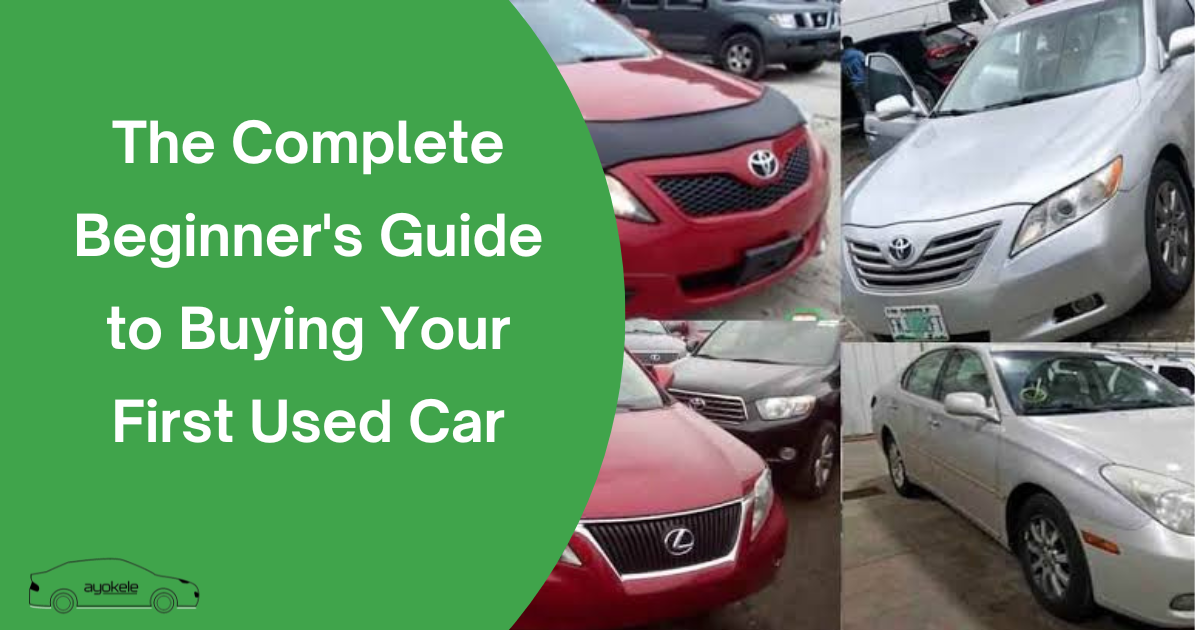Buying a used car for the first time can feel overwhelming, but with the right guidance, it can also be a smart and rewarding experience. Used cars offer an affordable way to own a vehicle without the hefty price tag of a brand-new model. They also provide a wide variety of options, from different brands to various models, ensuring you can find a car that fits your needs and budget.
In this guide, we’ll walk you through the essential steps to make your first used car purchase a success. We’ll show you exactly how to find a reliable ride without breaking the bank – from crunching the numbers and spotting red flags during inspection to negotiating like a pro and sealing the deal.
How to Inspect a Used Car Before Buying
1. Exterior Inspection
Start by thoroughly examining the exterior of the car. Look for dents, scratches, rust, and inconsistencies in the paintwork, as these could indicate past accidents or poor maintenance. Check for alignment issues by inspecting gaps between doors, the hood, and the trunk, as uneven gaps might suggest the car has been repaired after an accident. Also, inspect the windshield and windows for cracks or chips that may need replacement.
Pay close attention to the headlights, taillights, and side mirrors to ensure they’re in good condition and functioning properly. While minor scratches or dents may not affect the car’s performance, they can provide leverage during price negotiations. Taking your time to inspect the exterior helps ensure you don’t overlook visible signs of wear or damage.
2. Interior Inspection
The interior of the car is where you’ll spend most of your time, so it’s essential to ensure it’s in good condition. Check the seats for tears, stains, or unusual odors. Test all electronics, including the radio, air conditioning, heater, and power windows, to confirm they’re working properly. Don’t forget to check the dashboard for warning lights, as these may indicate underlying issues that require attention.
Inspect the condition of the steering wheel, gear stick, and pedals for signs of excessive wear, which may suggest high usage or poor handling. Make sure the seatbelts are functioning properly and free of damage. A clean and functional interior contributes to a comfortable driving experience and adds value to the car.
3. Test Drive
A test drive is one of the most important steps in inspecting a used car. During the test drive, pay attention to how the car handles on the road. Listen for any unusual noises from the engine, brakes, or suspension. Ensure the car accelerates smoothly, shifts gears properly, and brakes effectively. Test the steering for responsiveness and alignment, as any pulling to one side may indicate a problem.
Drive on different types of roads, including highways and rougher terrains, to get a better sense of the car’s overall performance. A test drive helps you identify any issues that may not be visible during a stationary inspection and ensures the car is comfortable and reliable to drive.
4. Under the Hood Inspection
Inspecting the engine and components under the hood is crucial to ensure the car is in good mechanical condition. Check the engine oil, coolant, brake fluid, and transmission fluid levels to confirm they are at the proper levels and free of contamination. Look for signs of oil leaks or corrosion around the engine, which could indicate neglect or potential problems.
Inspect the belts and hoses for any signs of cracks, wear, or fraying. Also, check the battery terminals for corrosion and confirm that the battery is securely fastened. If you’re not confident in your ability to inspect under the hood, consider bringing along a trusted mechanic to ensure there are no hidden issues.
5. Tires and Brakes
Check the condition of the tires for even wear and adequate tread depth. Uneven tire wear could indicate alignment issues or suspension problems. Verify that all four tires match in brand and size, as mismatched tires can affect the car’s performance and safety. Don’t forget to inspect the spare tire to ensure it’s in usable condition.
Test the brakes for responsiveness by applying them during the test drive. Listen for any grinding or squeaking noises, which could indicate worn brake pads or rotors. Brakes are a critical safety feature, so ensuring they’re in good condition is non-negotiable when buying a used car.
Where to Buy Used Cars In Nigeria
1. Dealerships
One of the most trusted places to buy a used car is from licensed dealerships. Dealerships often provide a wide range of options, including certified pre-owned cars that have been thoroughly inspected and come with a limited warranty. Buying from a dealership ensures you’re getting a vehicle that meets specific quality standards. Additionally, dealerships usually handle all the necessary paperwork, such as ownership transfer and registration, saving you time and effort.
However, cars at dealerships may be slightly more expensive than those sold by private sellers. The added cost reflects the dealership’s inspection and warranty services, which offer peace of mind for first-time buyers. If you’re looking for reliability and a hassle-free experience, dealerships are a great choice.
2. Private Sellers
Private sellers are another common source for buying used cars in Nigeria. These are individuals who are selling their personal vehicles, often at lower prices than dealerships. Buying from a private seller can be a good deal, especially if the seller is transparent about the car’s history and condition. It’s also an opportunity to negotiate the price and potentially save money.
However, purchasing from a private seller comes with risks. There is no warranty or guarantee, and the responsibility for inspecting the car falls entirely on you. It’s important to verify the car’s history and ensure all documents are valid and up-to-date. To avoid scams, meet the seller in a safe public place and, if possible, bring along a trusted mechanic to inspect the vehicle.
3. Online Platforms
In recent years, online platforms have become a popular way to buy used cars in Nigeria. Websites like Jiji, Cars45, and Autochek allow buyers to browse a wide selection of vehicles from the comfort of their homes. These platforms often include detailed listings with photos, specifications, and seller contact information, making it easy to compare options.
While online shopping is convenient, it’s important to be cautious. Always verify the seller’s credibility and physically inspect the car before making any payments. Be wary of deals that seem too good to be true, as they could be scams. Online platforms can be a great starting point for your search, but ensure you follow up with in-person inspections and secure transactions.
Common Mistakes to Avoid When Buying a Used Car
1. Skipping a Test Drive
One of the biggest mistakes you can make when buying a used car is failing to take it for a test drive. A test drive is your chance to evaluate the car’s performance on the road and identify potential issues such as unusual noises, poor acceleration, or unresponsive brakes. Without a test drive, you’re essentially buying the car without knowing how it handles or performs.
During the test drive, try different driving conditions, such as city streets and highways, to assess how the car reacts. Pay attention to the steering, alignment, and overall comfort. Skipping this step increases the risk of purchasing a car with hidden problems that may lead to costly repairs later.
2. Ignoring the Car’s History Report
Another common mistake is neglecting to review the car’s history report. A history report provides essential information, such as previous accidents, maintenance records, and whether the car has ever been stolen or written off. Ignoring this report could mean buying a car with a troubled past, which may affect its safety and reliability.
Always request a detailed history report from the seller or obtain it from reputable platforms. If the seller cannot provide one, proceed with caution. A car with a clean history is less likely to have hidden issues and will give you greater peace of mind about your purchase.
3. Not Setting a Clear Budget
Failing to set a clear budget is a mistake that can lead to overspending. Many first-time buyers focus only on the purchase price and forget to account for additional costs, such as insurance, registration fees, and maintenance. Without a clear budget, you may end up with a car you can’t afford to maintain.
Before starting your search, calculate how much you’re willing to spend, including these extra costs. Sticking to your budget ensures you don’t strain your finances and allows you to focus on cars that fit within your price range.
4. Overlooking a Professional Inspection
Relying solely on your own judgment when inspecting a used car can be a costly mistake, especially if you lack mechanical expertise. Many buyers overlook the importance of getting a professional mechanic to inspect the car before finalizing the deal. This can result in purchasing a vehicle with serious mechanical issues or hidden damage.
A professional inspection can uncover problems you might miss, such as engine faults, transmission issues, or structural damage. While it may cost a little extra, it can save you from expensive repairs and ensure you’re making a sound investment.
5. Failing to Negotiate the Price
Many buyers accept the asking price without attempting to negotiate, which can lead to overpaying for the car. Sellers often price used cars with room for negotiation, so failing to haggle means you might miss out on a better deal.
Before negotiating, research the market value of the car to understand what a fair price should be. Use any issues you discover during the inspection, such as worn tires or minor scratches, as leverage to lower the price. Negotiation is a standard part of buying a used car, so don’t hesitate to advocate for a fair deal.
Tips for Negotiating a Fair Price
1. Research the Market Value of the Car
Before entering negotiations, it’s important to know the market value of the car you’re interested in. Use online platforms like Jiji, Cars45, or Autochek to compare prices for similar models, considering factors such as year, mileage, and condition. This information gives you a benchmark for what the car is worth and prevents you from overpaying.
With this knowledge, you can confidently counter the seller’s asking price if it’s significantly higher than the market average. Showing that you’ve done your research also positions you as an informed buyer, making it harder for the seller to inflate the price.
2. Highlight Issues Found During the Inspection
Use the results of your inspection as leverage during negotiations. If you’ve identified minor issues such as scratches, worn tires, or needed repairs, bring these up to justify asking for a lower price. For example, if the tires are close to needing replacement, calculate the cost of new tires and suggest deducting that amount from the asking price.
Sellers are often willing to adjust the price when confronted with valid concerns about the car’s condition. However, be reasonable in your requests and focus on issues that genuinely impact the car’s value or your repair costs.
3. Be Polite but Firm
Negotiation doesn’t have to be a confrontational process. Approach the seller politely and respectfully, but remain firm in your position. Clearly state your budget and the reasons behind your offer, backing it up with your research and inspection findings.
If the seller isn’t willing to meet your price, be prepared to walk away. Letting the seller know that you have other options can often encourage them to reconsider and offer a more favorable deal. Staying polite yet assertive increases your chances of reaching a fair agreement.




